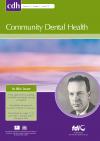Community Dental Health

- Cover Date:
- June 2010
- Print ISSN:
- 0265 539X
- Vol:
- 27
- Issue:
- 2
Development of a measure of childhood information learning experiences related to dental anxiety
Objective The aim of this study was to develop a measure of childhood information learning experiences related to dental anxiety according to Rachman’s theory of fear acquisition entitled “Dental Information Learning History Questionnaire (DILHQ)†and to determine its test quality with regard to factorial validity, reliability, divergent, discriminant, and predictive validity. Method Sample 1 included 228 dental patients, answering a 17-item-pool of the DILHQ, the Dental Anxiety Scale (DAS: Corah, 1969), and the Self-Consciousness Scale by Fenigstein et al. (1975). A second sample of 197 patients filled in the final 12-item test version, the DAS and the state version of the State-Trait Anxiety Inventory (Spielberger et al., 1970). Ninety-five participants constituting the third sample answered the DILHQ twice with a 14-days interval. Results An exploratory study using the first sample resulted in two dimensions underlying the DILHQ-answers after removal of the unique loading items. The two-factorial structure was confirmed in the second sample. The factor-analytically derived Danger Information and Acceptance Information subscales showed sufficient internal consistency (Alpha=0.87 and 0.72) and temporal stability (rtt=0.77 and 0.76). Dentally fearful patients remembered being exposed to more danger information and less acceptance information about dentistry during childhood than low-fearful patients did (p<0.001 each). Danger information and acceptance information predicted anxious response to the following dental procedure in opposite directions (r=0.29 and r=-0.29). Conclusion The results suggest that the DILHQ fulfils criteria of good construct validity. Exposure to threatening information about dentistry during childhood may increase the risk for dental fear acquisition and for exaggerated anxious response to treatment, while acceptance information might have a protective effect.
Key words: Dental anxiety, factor analysis, information learning, test development,validity
- Article Price
- £15.00
- Institution Article Price
- £
- Page Start
- 122
- Page End
- 128
- Authors
- U. Klages, T. Einhaus, Y. Seeberger, H. Wehrbein
Articles from this issue
- Title
- Pg. Start
- Pg. End
- A health equity methodology for auditing oral health and NHS General Dental Services in Sheffield, England.
- 68
- 73
- Effectiveness of structured comprehensive paediatric oral health education for parents of children less than two years of age in Germany
- 74
- 80
- Reliability analysis of visual examinations carried out by schoolteachers and a dental assistant in the detection of dental caries.
- 89
- 93
- Caries experience and oral health behaviour among 11 – 13-year-olds: an ecological study of data from 27 European countries, Israel, Canada and USA
- 102
- 108
- Development of a measure of childhood information learning experiences related to dental anxiety
- 122
- 128
